In this article:
Blood pumped throughout the body exerts a force on the artery walls, known as blood pressure.

Blood pressure lower than the normal range is called low blood pressure or hypotension. This condition is usually good for health, as it reduces the risk of heart problems and stroke.
However, in some cases, the pressure might be very low that it impedes the supply of oxygenated blood to the organs and requires medical treatment.
What Is a Blood Pressure Reading?
A blood pressure reading is composed of two measurements:
- Systolic: This is the higher number that indicates the pressure in the blood vessels when the heart pumps blood.
- Diastolic: This is the lower number that represents the pressure when the heart is in a relaxed position.
The standard normal blood pressure is 120/80 mmHg, which is 120 mmHg systolic and 80 mmHg diastolic.
There are no standard values for hypotension, but blood pressure below 90/60 mmHg is considered hypotensive.
Types of Low Blood Pressure
Hypotension can be classified into various types:
- Orthostatic Hypotension: In this condition, the blood pressure fails to adjust to gravity on suddenly standing, sometimes resulting in light-headedness or, in more severe cases, syncope or fainting. (1)
- Neurocardiogenic Syncope: The nerves that control the blood vessels may sometimes give an inappropriate signal, causing the blood vessels to expand. As a result, blood pools in the legs, and blood supply to the brain is reduced, sometimes leading to fainting.
- Postprandial Hypotension: It refers to a feeling of dizziness or light-headedness due to low blood pressure after a meal.
- Severe Hypotension: This can result from a severe infection (sepsis), sudden blood loss (shock), severe allergic reaction (anaphylaxis), and heart attack.
Causes of Low Blood Pressure

Various factors can contribute to low blood pressure, including:
1. Pregnancy
Due to the hormonal changes and expansion of the blood vessels during pregnancy, it is common to experience blood pressure fluctuations during this period.
2. Heart disease
Certain heart problems can affect the pumping efficacy of the heart, causing the blood pressure to drop.
3. Kidney diseases
These can cause an imbalance of electrolytes, which affects the amount of water in your blood vessels, leading to less blood volume and, consequently low blood pressure.
4. Anemia
A deficiency of some nutrients can hamper the production of red blood cells and therefore affect the oxygen-carrying capacity of the blood.
5. Endocrine problems
These include conditions such as hypothyroidism, adrenal insufficiency (Addison’s disease), low blood sugar, and parathyroid disease.
6. Eating
After consuming meals, the blood flow of the body is concentrated on the digestive system. Such a drop in blood pressure is more common in people who have autonomic nervous system problems such as Parkinson’s and long-term diabetes.
7. Medications
Certain drugs can cause a drop in blood pressure, including:
- Diuretics
- Hypertension medicines (beta-blockers, calcium channel blockers, ACE inhibitors, ARBs, and some others)
- Many OTC or prescription drugs, which when taken with high blood pressure medications can cause a decrease in blood pressure
- Parkinson’s medications
- Tricyclic antidepressants
- Certain antihistamines (diphenhydramine, cetirizine, etc.)
- Erectile dysfunction drugs, especially those with nitroglycerine
Some other common causes of hypotension include heart failure, dehydration, arrhythmia, nerve damage due to diabetes, high body temperature, emotional stress, profuse bleeding, plaque buildup, and aging.
Symptoms of Low Blood Pressure
A decrease in blood pressure may lead to the following symptoms:
- Unsteadiness
- Dizziness or light-headedness
- Fainting
- Blurred vision
- Weakness
- Nausea
- Sweating
- Stiff neck
- Pale, clammy skin
- Heart palpitations
An extremely low blood pressure impedes the supply of oxygen and nutrients to the body’s organs and tissues. This can lead to shock, in which immediate medical treatment is crucial.
The symptoms of shock include:
- Rapid breathing
- Cold and sweaty skin
- Blue skin tone
- Weak or rapid pulse
Standard Medical Treatment for Low Blood Pressure

Generally, low blood pressure can be corrected with lifestyle changes. Medicines are only given if your low blood pressure is causing complications.
The medications given for low blood pressure depend on the underlying cause, such as antibiotics for an infection. The commonly used drugs for low blood pressure include:
1. Beta or alpha agonists
Beta-agonists cause the heart to beat faster, whereas alpha agonists induce constriction of the blood vessels.
2. Fludrocortisone
This drug helps the kidneys to retain water and salt, thereby increasing the volume of blood in the body and, therefore, the blood pressure.
3. Midodrine
This drug is a vasoconstrictor that helps narrow the blood vessels, consequently increasing the blood pressure. It is commonly used for orthostatic hypotension.
Severe hypotension caused by shock requires immediate treatment, which may involve:
- Blood transfusion
- Medications that improve heart function and blood pressure
- Antibiotics and other medications depending on the cause of shock
Diagnosing Hypotension

The primary test for diagnosing low blood pressure involves measuring your blood pressure. Your doctor will also analyze your medical history, symptoms, and medications to determine the cause of low blood pressure.
Additionally, your doctor may suggest the following tests:
- Physical exam
- Heart rate measurement in lying, sitting, and standing positions
- Blood pressure measurement in lying, sitting, and standing positions
- Blood tests
- Urine tests
- Imaging tests
- Tilt table test, if you faint often
- Ambulatory blood pressure monitoring
Complications Associated With Low Blood Pressure
Low blood pressure can cause fainting and dizziness, especially in adults, which can lead to falls and severe injuries.
A sudden drop in blood pressure limits the oxygen supply, causing damage to organs such as the kidneys, heart, and brain. This is commonly seen in impending or fulminant shock.
When to See a Doctor
Seek immediate medical attention if you experience any of the following symptoms:
- Dizziness or fainting
- Blurred vision
- Weakness
- Shortness of breath
- Chest pain or tightness
- Severe headache
- Swelling of the lips or throat
- Heart palpitations
- Rash
- Tarry, discolored, or bloody stools
- Slurred speech
- Chills or fever above 100.5°F
Final Word
Low blood pressure can often cause dizziness or fainting due to a lack of blood supply to the brain. Consult your doctor to determine the underlying cause of your low blood pressure and for a proper diagnosis. In severe cases of hypotension, IV fluids may be given for treatment.

- Was this article helpful?
- YES, THANKS!NOT REALLY


